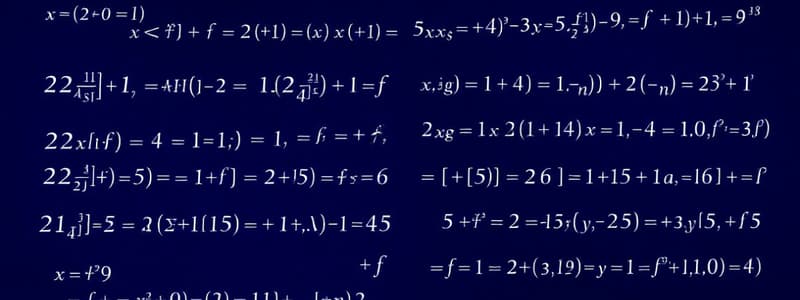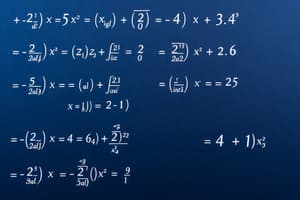Podcast
Questions and Answers
What is the standard form of a quadratic equation?
What is the standard form of a quadratic equation?
- ax² + bx = c
- ax² + bx + c = 0 (correct)
- a + bx + c = 0
- ax² + bx + c = 1
What does the discriminant in the quadratic formula determine?
What does the discriminant in the quadratic formula determine?
- The maximum value of the quadratic function
- The number of solutions and their nature (correct)
- The x-coordinate of the vertex
- The width of the parabola
Which method can be used to solve a quadratic equation that is not factorable?
Which method can be used to solve a quadratic equation that is not factorable?
- Factoring
- Completing the square
- Quadratic Formula (correct)
- Only graphing
If a quadratic equation has a negative discriminant, what can be inferred about its roots?
If a quadratic equation has a negative discriminant, what can be inferred about its roots?
Which of the following statements about the vertex of a parabola is true?
Which of the following statements about the vertex of a parabola is true?
When does a parabola open downwards in a quadratic equation?
When does a parabola open downwards in a quadratic equation?
In which application might quadratic equations be utilized?
In which application might quadratic equations be utilized?
What is the shape of the graph represented by a quadratic equation?
What is the shape of the graph represented by a quadratic equation?
Flashcards
Quadratic Equation
Quadratic Equation
A polynomial equation of the second degree. It has the form ax² + bx + c = 0, where 'a', 'b', and 'c' are constants, and 'a' is not zero. 'x' represents an unknown value.
Standard Form
Standard Form
The standard form of a quadratic equation is ax² + bx + c = 0, where 'a', 'b', and 'c' are coefficients that can be any real numbers.
Roots (Solutions)
Roots (Solutions)
The solutions to the equation. They are the values of 'x' that make the equation true.
Discriminant
Discriminant
Signup and view all the flashcards
Completing the Square
Completing the Square
Signup and view all the flashcards
Parabola
Parabola
Signup and view all the flashcards
Vertex
Vertex
Signup and view all the flashcards
Axis of Symmetry
Axis of Symmetry
Signup and view all the flashcards
Study Notes
Definition and Basic Form
- A quadratic equation is a polynomial equation of the second degree.
- It's typically written in the form ax² + bx + c = 0, where 'a', 'b', and 'c' are constants, and 'a' is not zero.
- The variable 'x' represents an unknown value.
Standard Form
- The standard form of a quadratic equation is ax² + bx + c = 0.
- 'a', 'b', and 'c' are coefficients, and they can be any real numbers.
- 'x' is the variable.
Solving Quadratic Equations
- Several methods exist to solve quadratic equations.
- Factoring: If factorable, rewrite as (px + q)(rx + s) = 0. Solve for x.
- Quadratic Formula: x = (-b ± √(b² - 4ac)) / 2a. Solves any quadratic equation.
- Completing the square: Rewrites the equation into a perfect square trinomial.
- Graphing: Plot the parabola y = ax² + bx + c and find the x-intercepts.
Discriminant
- The discriminant is the part of the quadratic formula under the square root: b² - 4ac.
- It indicates the nature of the quadratic equation's roots.
- Positive discriminant: Two distinct real roots.
- Zero discriminant: One real root (or two identical roots).
- Negative discriminant: No real roots; two complex roots.
Roots (Solutions)
- Roots (solutions) are the values of 'x' satisfying the equation.
- They represent the x-intercepts of the quadratic function's graph.
Properties of Parabolas
- The graph of a quadratic equation is a parabola.
- Parabola opens upwards if 'a' is positive, downwards if 'a' is negative.
- The vertex is the maximum or minimum point.
- The axis of symmetry is a vertical line through the vertex.
Vertex of a Parabola
- The vertex is where the parabola changes from increasing to decreasing (or vice versa).
- The x-coordinate of the vertex is -b / 2a.
Applications of Quadratic Equations
- Quadratic equations model various scenarios, including:
- Projectile motion calculations.
- Finding maximum or minimum areas of shapes.
- Modeling growth or decay processes.
Example Problems
- Examples using factoring, the quadratic formula, or graphing will demonstrate these concepts.
Types of Roots
- The discriminant (b² - 4ac) determines the nature of the roots.
- Real and distinct: Two different real number roots.
- Real and equal: One real number root (repeated root).
- Imaginary (complex): Two complex (imaginary) roots.
Studying That Suits You
Use AI to generate personalized quizzes and flashcards to suit your learning preferences.




